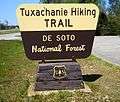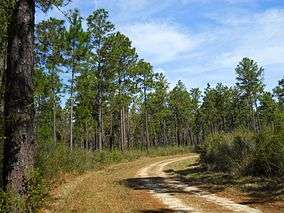De Soto National Forest
| De Soto National Forest | |
|---|---|
|
IUCN category VI (protected area with sustainable use of natural resources) | |
|
View of a pine forest in De Soto National Forest, Stone County, Mississippi | |
 | |
| Location | Mississippi, USA |
| Nearest city | Hattiesburg, MS |
| Coordinates | 31°04′01″N 88°59′00″W / 31.066944°N 88.983333°WCoordinates: 31°04′01″N 88°59′00″W / 31.066944°N 88.983333°W |
| Area | 518,587 acres (2,098.65 km2)[1] |
| Established | June 15, 1936 |
| Governing body | U.S. Forest Service |
| http://www.fs.usda.gov/mississippi | |
De Soto National Forest, named for 16th-century explorer Hernando de Soto, is 518,587 acres (810 sq mi; 2,099 km2) of pine forests in southern Mississippi. It is one of the most important protected areas for the biological diversity of the Gulf Coast ecoregion of North America.[2] It is a nationally important site for protection of longleaf pine savannas, pine flatwoods, and longleaf pine forests. More than 90 percent of this ecosystem type has been lost in the United States[3] . The wet pine savannas support rare and endangered plant and animal species, such as the orchid Calopogon multiflorus, gopher frogs, and gopher tortoises. These habitats also have large numbers of carnivorous plants, particularly pitcher plants;[4] Buttercup Flats has an international reputation in this regard.[5]
It also offers year-round opportunities for outdoor activities including camping, canoeing, bird-watching, photography, hunting, fishing, and more. There are two nationally significant wilderness areas within DeSoto: Black Creek Wilderness and Leaf River Wilderness. Black Creek is a popular stream for canoeing, camping, and fishing, and is Mississippi's only designated National Wild and Scenic River. Two National Recreational Trails, the Black Creek Trail and Tuxachanie Trail, offer more than 60 miles (96.6 km) of hiking opportunities.
The forest is headquartered in Jackson, as are all six National Forests in Mississippi. The local ranger district office is in Wiggins, which is surrounded by the National Forest on three sides: north, east, and south.
De Soto National Forest is located between Hattiesburg and Gulfport, and can be easily accessed by U.S. Highway 49 and U.S. Highway 98. It lies in parts of ten counties. In descending order of land area they are Perry, Wayne, Harrison, Forrest, Stone, Greene, Jones, Jackson, George, and Pearl River counties.
Gallery
-

De Soto National Forest Ranger District Office in Wiggins, Mississippi
-

See also
- De Soto National Memorial, on the west coast of Florida
- List of U.S. National Forests
- Brooklyn, Mississippi
- Perry County, Mississippi
- Black Creek Wilderness
- Red Creek
- Red Creek Wildlife Management Area (Mississippi)
- Leaf River Wildlife Management Area
References
- ↑ "Land Areas of the National Forest System" (PDF). U.S. Forest Service. January 2012. Retrieved June 24, 2012.
- ↑ Keddy, P.A. 2009. Thinking big: A conservation vision for the Southeastern coastal plain of North America. Southeastern Naturalist 8: 213-226 .
- ↑ White, P.S., S.P. Wilds, and G.A. Thunhorst. 1998. Southeast. Pp. 255–314, In M.J. Mac, P.A. Opler, C.E. Puckett Haecker, and P.D. Doran (Eds.). Status and Trends of the Nation’s Biological Resources. 2 vols. US Department of the Interior, US Geological Survey, Reston, VA.
- ↑ Nelson, Gil. 2005. East Gulf Coastal Plain Wildflowers: A Field Guide to the Wildflowers of the East Gulf Coastal Plain, Including Southwest Georgia, Northwest Florida, Southern Alabama, Southern Mississippi, and Parts of Southeastern Louisiana. The Globe Pequot Press, Guilford, CT.
- ↑ Clark, M.A., J. Siegrist and P.A. Keddy. 2008. Patterns of frequency in species-rich vegetation in pine savannas: effects of soil moisture and scale. Ecoscience 15: 529-535.
